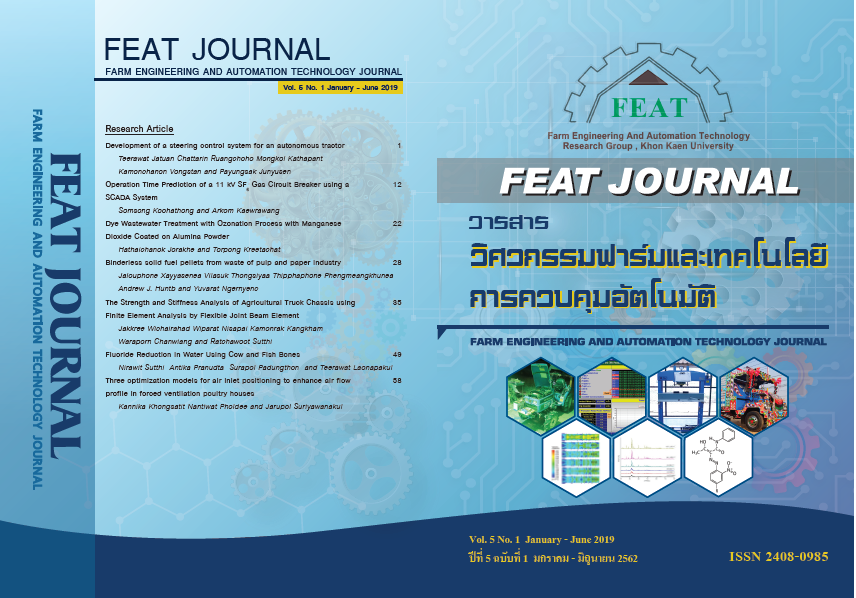Binderless solid fuel pellets from solid waste of pulp and paper industry
Main Article Content
บทคัดย่อ
This research studied the preparation of solid fuel pellets from wood dust waste of the pulp and paper industry. Pelletization by a hydraulic press at 20 to 50 bar was utilized to produce fuel pellets with diameter of 1 or 1.5 cm and height of 1.25 cm. The properties of fuel pellet including calorific value (heating value), pellet density, bulk density, moisture and ash content were characterized. These results demonstrated that the minimum pressure required to produce binderless pellets with a 1 cm diameter was 30 bar and this increased to 40 bar for pellets of a 1.5 cm diameter. The heating value of the resulting fuel pellets was between 15,401–16,388 kJ/kg, which is significantly higher than the unpelletized raw material (14,986 kJ/kg). Density of the fuel pellets was between 0.51–0.69 g/cm3 and the bulk density was 0.30–0.40 g/cm3. Densification of raw material through pelletization increased the bulk density of sample, thus reducing transportation and storage costs. In addition, the uniform size and shape made pelleted fuels easier to handle and reduced hazards associated with dust. Such processes are ideal for creating new opportunities for the development of solid fuels from paper wastes and could provide an opportunity for power generation within the pulping mill.
Article Details
วารสารวิศวกรรมฟาร์มและเทคโนโลยีควบคุมอัตโนมัติ (FEAT Journal) มีกําหนดออกเป็นราย 6 เดือน คือ มกราคม - มิถุนายน และ กรกฎาคม - ธันวาคม ของทุกปี จัดพิมพ์โดยกลุ่มวิจัยวิศวกรรมฟาร์มและเทคโนโลยีควบคุมอัตโนมัติ คณะวิศวกรรมศาสตร์มหาวิทยาลัยขอนแก่น เพื่อเป็นการส่งเสริมและเผยแพร่ความรู้ ผลงานทางวิชาการ งานวิจัยทางด้านวิศวกรรมศาสตร์และเทคโนโลยีพร้อมทั้งยังจัดส่ง เผยแพร่ตามสถาบันการศึกษาต่างๆ ในประเทศด้วย บทความที่ตีพิมพ์ลงในวารสาร FEAT ทุกบทความนั้นจะต้องผ่านความเห็นชอบจากผู้ทรงคุณวุฒิในสาขาที่เกี่ยวข้องและสงวนสิทธิ์ ตาม พ.ร.บ. ลิขสิทธิ์ พ.ศ. 2535
เอกสารอ้างอิง
[2] Munawar SS, Subiyanto B. Characterization of Biomass Pellet Made from Solid Waste Oil Palm Industry. Procedia Environment Science 2014; 20: 336-341.
[3] Stele W, et al. Fuel pellets from biomass: The importance of the pelletizing pressure and its dependency on the processing conditions. Fuel 2011; 90: 3285-3290.
[4] Theerarattananoon K, et al. Physical properties of pellets made from sorghum stalk, corn stove, wheat straw, and big bluestem. Industrial Crops and Products 2011; 33: 325-332.
[5] Purwanto WW, et al. Characteristics of biomass pellet as fuel. Proceedings of International Seminar on Sustainable Biomass Production and Utilization: Challenges and Opportunities (ISOMASS); 2009 Aug 3-4; The University of Lampung, Indonesia.
[6] Shang L, et al. Quality effects caused by torrefaction of pellets made from Scots pine. Fuel Processing Technology 2012; 101: 23-28.
[7] Cao L, et al. Complementary effects of torrefaction and co-pelletization: Energy consumption and characteristics of pellets. Bioresource Technology 2015; 185: 254-262.


